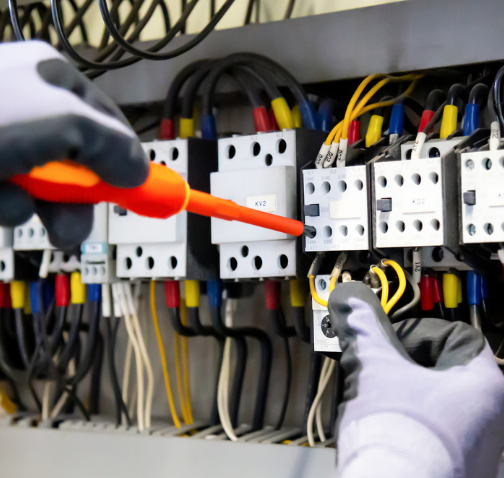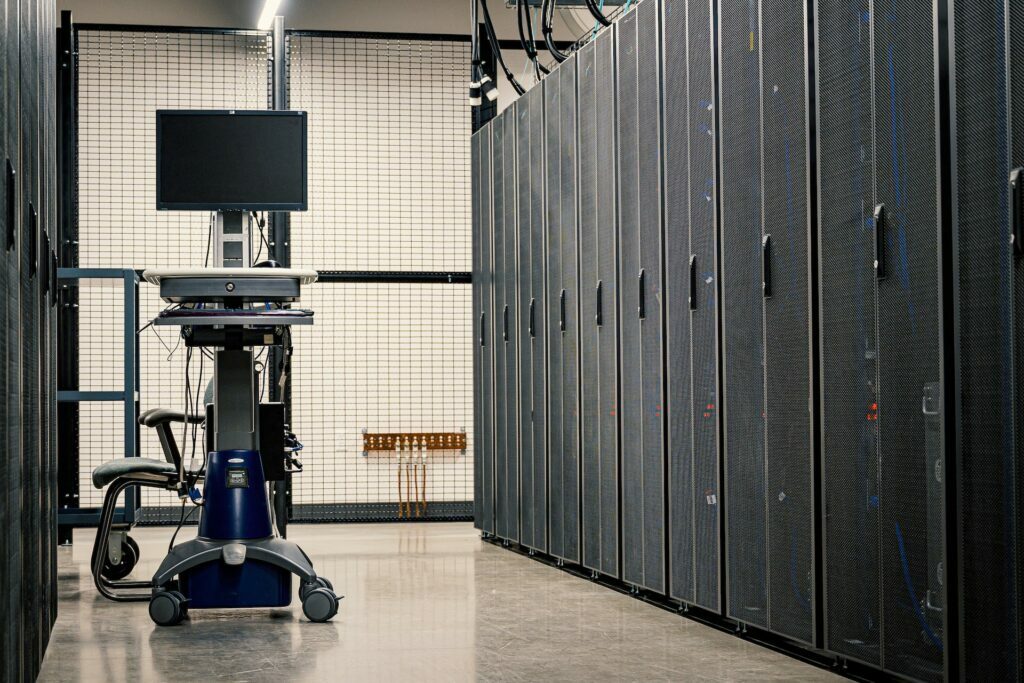Data Center Backup Power: Every data center, as we all know, requires ideal, continuous electricity every single day. Any power outage of any kind may be disastrous because mainframes can break down, data can be lost or damaged, and eventually, money can get lost. The valuable information regarding data center backup power and its importance is provided in this article.
General Information Schematic for Backup Power for Data Centers
It’s essential to comprehend the parts of the power distribution system in the building where the data center is housed. The following are the key elements of power distribution:
Generator
Power is provided by an emergency generator when utilities are unavailable. Utility electricity is the facility’s primary source of energy. A “Generator” plays a crucial role in ensuring uninterrupted power supply and maintaining the operational integrity of the data center. A generator is a device that converts mechanical energy into electrical energy. It serves as a reliable backup power source to mitigate the risks of power outages and minimize potential disruptions to critical data center operations.
Here are a few significant aspects of generators in the context of backup power for data centers:
- Reliable Power Source: Data centers house mission-critical equipment and infrastructure that require continuous power to operate without interruption. Generators provide a reliable backup power source, ensuring that the data center remains operational during power outages or grid failures.
- Uninterrupted Operations: The downtime of a data center can result in significant financial losses, reputational damage, and impact on customer satisfaction. Generators act as a reliable standby power source, enabling data centers to continue their operations seamlessly and minimize any potential disruptions.
- Load Capacity: Data centers consume massive amounts of power due to the extensive computing equipment and cooling systems they house. Generators are designed to handle high electrical loads, making them capable of providing sufficient power to support the entire data center’s infrastructure.
- Quick Response Time: Generators are engineered to provide power within seconds of a power outage, ensuring a swift transition and minimizing any interruptions to critical systems. This quick response time is crucial in maintaining the seamless operation of data center equipment and preventing data loss or system failures.
- Fuel Redundancy and Autonomy: Backup generators in data centers often have built-in fuel storage, ensuring an autonomous power supply. These generators can run for extended periods using diesel or other fuels, providing backup power until the primary power source is restored.
- Scalability: Data centers require scalable power solutions to accommodate their growing needs. Generators can be sized and configured to meet the specific power demands of a data center, allowing for scalability and expansion as the data center’s requirements evolve over time.
- Testing and Maintenance: Generators undergo regular testing and maintenance to ensure their reliability and functionality. Data center operators perform routine inspections, load tests, and maintenance procedures to verify the generators’ readiness and identify any potential issues proactively.
- Compliance and Regulations: Data centers often need to comply with industry standards and regulations that mandate backup power systems. Generators play a crucial role in meeting these requirements and certifications, ensuring data centers adhere to guidelines regarding power redundancy, backup capabilities, and disaster recovery.
Automatic Switch Gear
Supplies switch gear with electricity from a utility or emergency generator.

Image Courtesy – PCX
Switchgear (Switch Gear): Distributes utility or backup generator power. Battery bank, charger, and inverter make up the uninterruptible power supply. Switchgear acts as a crucial component in the electrical distribution system, ensuring a seamless transition between the primary power source and the backup power source, such as generators, during power outages or grid failures.
It plays a crucial role in backup power systems for data centers by managing power distribution, facilitating automatic transfer switching, ensuring fault protection, enabling load balancing, and offering scalability and flexibility. Its presence ensures a reliable and efficient backup power infrastructure, minimizing downtime, and safeguarding the continuous operation of critical data center equipment.
System Operation Normally
Utility, The switchgear receives power after passing via the automated transfer switch. Critical and non-critical supplies are separated in switchgear configurations. Components (such as data centers, security centers, and UPS) that need critical supplies cannot have their power cut off.
Power is provided to the UPS charger to maintain battery charge. HVAC Systems and Workstations are examples of non-critical components that do not have a redundant connection to the UPS inverter.
Standard Power Infrastructure for Data Centers
The larger municipal electric grid provides the majority of data centers with their principal energy. The facility will then either have one or more transformers installed to accept the energy while also guaranteeing that the electricity arriving is of the proper voltage and kind of current (converted from AC to DC typically).
Some data centers have on-site electrical generation equipment, either in the form of stand-alone generators or with alternative energy sources like solar photovoltaic panels and wind-powered turbines, which can either supplement their energy from the larger grid or completely remove the need for it.
After that, the main distribution boards get the electricity (MDBs). These “are panels or enclosures that hold fuses, circuit breakers, and ground leakage protection devices, take the low-voltage power and distribute it to a number of endpoints, such as Uninterrupted Power Supply (UPS) systems or load banks,” according to engineer Hans Vreeburg.
Breakers
A UPS is responsible for powering many breakers in addition to helping to “clean up” the energy that is pulsating by making sure that problems like surges don’t affect equipment. No more than seven or eight servers should be connected to a single breaker in a typical data center scenario, however, this number may vary depending on the breaker’s capacity and the server’s efficiency.
In the event of a power outage or other similar situations, UPS systems also act as a first backup. A basic UPS can power servers and breakers for up to five minutes, giving you ample time to rapidly start a backup generator in the event of an outage or other problems with the larger electric grid.
Power Reserves in Data Centers
The majority of data centers feature a backup power supply on site or close by in order to guarantee continuous uptime and reduce outages as much as feasible. Backup power is often provided by a fuel generator, which is run on either gasoline or diesel.
A Data Center uses how much Energy?
Managers must assure an adequate power to maintain data centers’ uninterrupted and ongoing operation. One study claims that the yearly power consumption of the whole data center sector exceeds 90 billion kilowatt hours. This is approximately the output of 34 coal-fired power facilities.
Data Centers utilise 3% of the total amount of power used worldwide. More than the whole power utilised in the United Kingdom, are these 416 terawatts.
There are a few reasons why energy consumption in data center facilities is so high and rising. All of the auxiliary equipment needs a lot of energy to operate, in addition to servers and other crucial components of IT equipment. Electricity is required for humidifiers, cooling systems, monitors, and other devices, which might sometimes drive up energy costs.
Utility Efficiency (PUE)
Facilities analyse energy input and utilisation effectiveness using a Power Usage Efficiency (PUE) score to identify how much power is used by servers vs non-IT equipment in a data center. A score of 1 indicates that all energy used in a data center is used exclusively by servers, while a score of 2 indicates that auxiliary equipment consumes the same amount of power as servers and other IT components.
The most recent study from the Uptime Institute indicates that a data center’s average PUE is 1.58. Since 2007 (when it was 2.5) and 2013, this number has been continuously falling (when it was 1.65).
The PUE for a Google Data Center is 1.12 on average, however, for the last three months of 2018, its Oklahoma facility only received a score of 1.08. FUNCTION
When the primary power source fails, backup generators provide electricity. Unfortunately, many parts of data centers are not designed to withstand sudden increases in power that result from moving from a regular to an emergency power source.
When these components lose power, even temporarily, a complete system restart is often necessary. Unfortunately, this may result in system outages, startup problems, component corruption, and information loss while a process is in progress.
Server Racks Arranged in Rows in a Data Center
A data center is a building that houses computer systems and related equipment, including phone and satellite connections as well as storage systems (hospitals, offices and internet providers). The following systems may be housed in data centers:
- Additional power controllers
- Redundant communications and data links
- Equipment for cooling server rooms
- Controls for HVAC and security

It is essential for operations that data centers have a 100% continuous power supply. To ensure that the components get consistent power, backup generators are deployed. In this post, we’ll look at:
- EPA restrictions and the purpose of backup generators
EMERGENCY VS. NORMAL
All data centers may run in two different modes: normally, using the utilities that are provided, or abnormally, using backup generators. Utility electricity is sent into the switchgear and via the automated transfer switch in normal operation.
The switchgear is set up for both essential and non-critical supplies, such as HVAC or workstations, as well as components that need continuous power, such as data centers or UPS.
When we refer to “Components” of a data center, we mean the following:
Power is delivered to both critical and non-critical loads through Switchgear.
Data centers and security are powered by an emergency generator until UPS resumes regular function.
The automated transfer switch switches electricity to the utility and powers both critical and non-critical loads when normal power is restored.
In this chain, the data center and security remain operational without any power interruptions.
Conclusion
As you can see, it is crucial to consider data center backup power. It may be a matter of life and death for vital components to have constant electricity!
In conclusion, the importance of data center backup power cannot be overstated. Data centers are the backbone of modern business operations, housing critical infrastructure and storing valuable data. Any disruption or downtime can result in significant financial losses and damage to reputation. Backup power systems, such as generators and switchgear, are essential in ensuring uninterrupted power supply during outages or emergencies. They provide a reliable and autonomous power source, allowing data centers to continue operations seamlessly.
The investment in robust backup power infrastructure is crucial for data centers to uphold service level agreements, protect against data loss, and maintain the trust and satisfaction of customers. The significance of data center backup power lies in its ability to mitigate risks, safeguard operations, and uphold the reliability and availability of critical systems.
